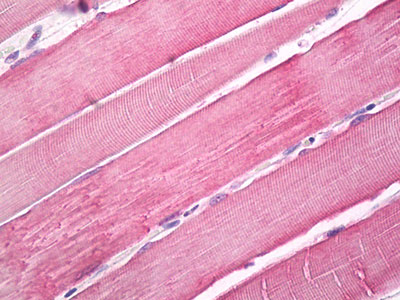MYO10 / Myosin-X Antibody (Internal)
Rabbit Polyclonal Antibody
- SPECIFICATION
- CITATIONS
- PROTOCOLS
- BACKGROUND

Application
| WB, IHC-P, E |
|---|---|
| Primary Accession | Q9HD67 |
| Reactivity | Human, Mouse, Bovine |
| Host | Rabbit |
| Clonality | Polyclonal |
| Calculated MW | 237kDa |
| Dilution | IHC-P (5 µg/ml), WB (1 µg/ml), |
| Gene ID | 4651 |
|---|---|
| Other Names | Unconventional myosin-X, Unconventional myosin-10, MYO10, KIAA0799 |
| Reconstitution & Storage | Long term: -20°C; Short term: +4°C. Avoid repeat freeze-thaw cycles. |
| Precautions | MYO10 / Myosin-X Antibody (Internal) is for research use only and not for use in diagnostic or therapeutic procedures. |
| Name | MYO10 |
|---|---|
| Synonyms | KIAA0799 |
| Function | Myosins are actin-based motor molecules with ATPase activity. Unconventional myosins serve in intracellular movements. MYO10 binds to actin filaments and actin bundles and functions as a plus end-directed motor. Moves with higher velocity and takes larger steps on actin bundles than on single actin filaments (PubMed:27580874). The tail domain binds to membranous compartments containing phosphatidylinositol 3,4,5-trisphosphate or integrins, and mediates cargo transport along actin filaments. Regulates cell shape, cell spreading and cell adhesion. Stimulates the formation and elongation of filopodia. In hippocampal neurons it induces the formation of dendritic filopodia by trafficking the actin-remodeling protein VASP to the tips of filopodia, where it promotes actin elongation. Plays a role in formation of the podosome belt in osteoclasts. |
| Cellular Location | Cytoplasm, cytosol. Cell projection, lamellipodium. Cell projection, ruffle. Cytoplasm, cytoskeleton. Cell projection, filopodium tip. Cytoplasm, cell cortex. Cell projection, filopodium membrane; Peripheral membrane protein. Note=May be in an inactive, monomeric conformation in the cytosol. Detected in cytoplasmic punctae and in cell projections. Colocalizes with actin fibers. Undergoes forward and rearward movements within filopodia Interacts with microtubules |
| Tissue Location | Ubiquitous.. |
| Volume | 50 µl |

Thousands of laboratories across the world have published research that depended on the performance of antibodies from Abcepta to advance their research. Check out links to articles that cite our products in major peer-reviewed journals, organized by research category.
info@abcepta.com, and receive a free "I Love Antibodies" mug.
Provided below are standard protocols that you may find useful for product applications.
Background
Myosins are actin-based motor molecules with ATPase activity. Unconventional myosins serve in intracellular movements. MYO10 binds to actin filaments and actin bundles and functions as plus end-directed motor. The tail domain binds to membranous compartments containing phosphatidylinositol 3,4,5-trisphosphate or integrins, and mediates cargo transport along actin filaments. Regulates cell shape, cell spreading and cell adhesion. Stimulates the formation and elongation of filopodia. May play a role in neurite outgrowth and axon guidance. In hippocampal neurons it induces the formation of dendritic filopodia by trafficking the actin-remodeling protein VASP to the tips of filopodia, where it promotes actin elongation. Plays a role in formation of the podosome belt in osteoclasts.
References
Berg J.S.,et al.J. Cell Sci. 113:3439-3451(2000).
Rogers M.S.,et al.J. Biol. Chem. 276:12182-12189(2001).
Takada T.,et al.Submitted (FEB-1999) to the EMBL/GenBank/DDBJ databases.
Nagase T.,et al.DNA Res. 5:277-286(1998).
Nagase T.,et al.Submitted (JAN-2003) to the EMBL/GenBank/DDBJ databases.
If you have used an Abcepta product and would like to share how it has performed, please click on the "Submit Review" button and provide the requested information. Our staff will examine and post your review and contact you if needed.
If you have any additional inquiries please email technical services at tech@abcepta.com.













 Foundational characteristics of cancer include proliferation, angiogenesis, migration, evasion of apoptosis, and cellular immortality. Find key markers for these cellular processes and antibodies to detect them.
Foundational characteristics of cancer include proliferation, angiogenesis, migration, evasion of apoptosis, and cellular immortality. Find key markers for these cellular processes and antibodies to detect them. The SUMOplot™ Analysis Program predicts and scores sumoylation sites in your protein. SUMOylation is a post-translational modification involved in various cellular processes, such as nuclear-cytosolic transport, transcriptional regulation, apoptosis, protein stability, response to stress, and progression through the cell cycle.
The SUMOplot™ Analysis Program predicts and scores sumoylation sites in your protein. SUMOylation is a post-translational modification involved in various cellular processes, such as nuclear-cytosolic transport, transcriptional regulation, apoptosis, protein stability, response to stress, and progression through the cell cycle. The Autophagy Receptor Motif Plotter predicts and scores autophagy receptor binding sites in your protein. Identifying proteins connected to this pathway is critical to understanding the role of autophagy in physiological as well as pathological processes such as development, differentiation, neurodegenerative diseases, stress, infection, and cancer.
The Autophagy Receptor Motif Plotter predicts and scores autophagy receptor binding sites in your protein. Identifying proteins connected to this pathway is critical to understanding the role of autophagy in physiological as well as pathological processes such as development, differentiation, neurodegenerative diseases, stress, infection, and cancer.


